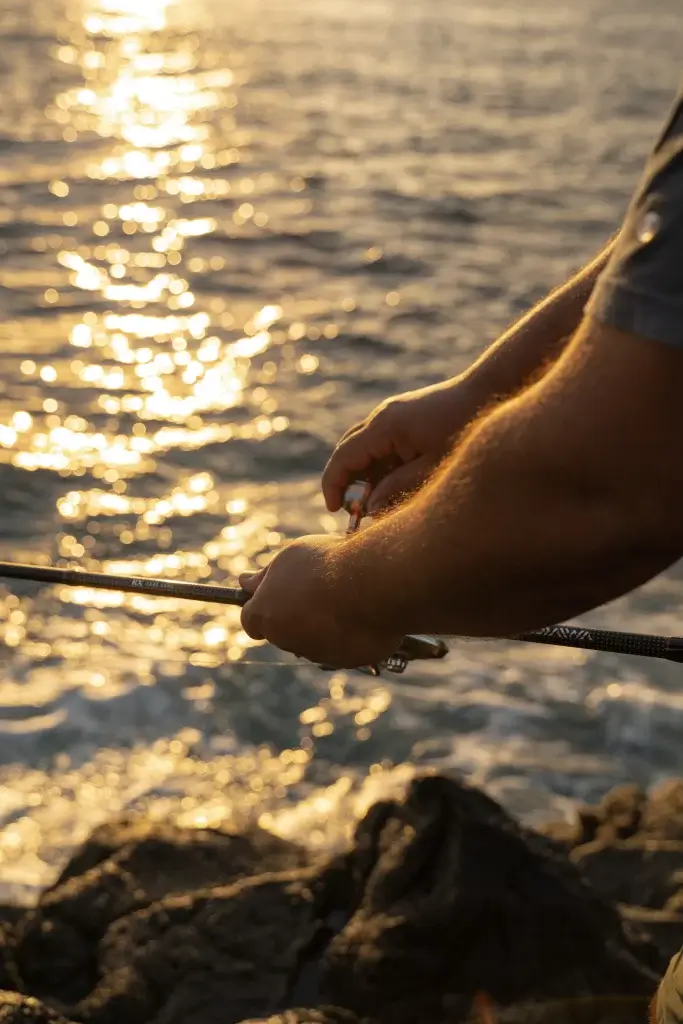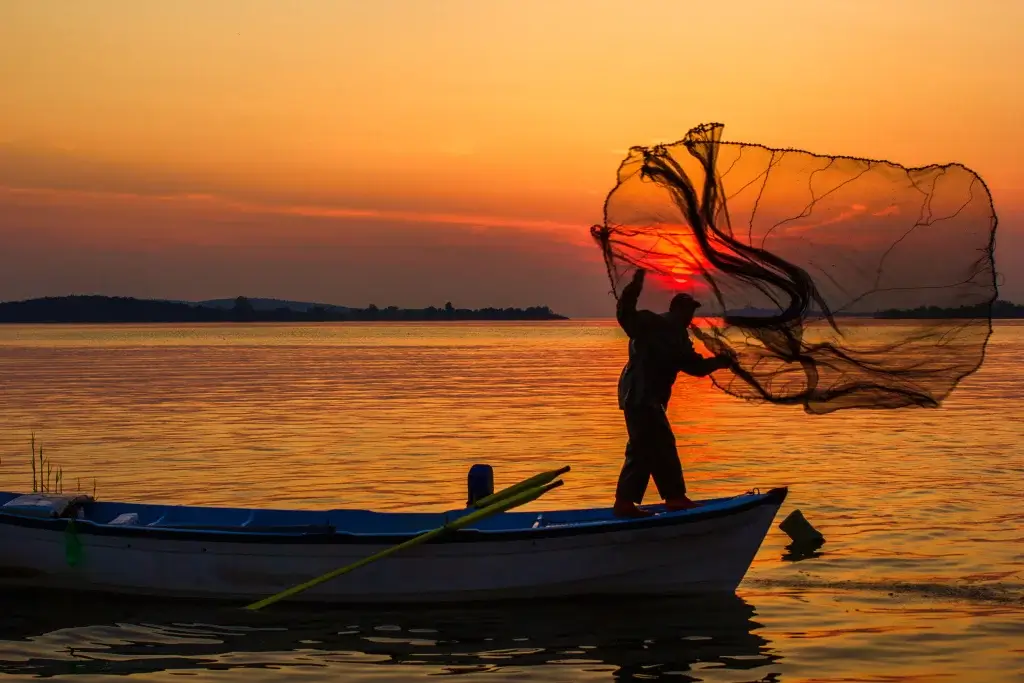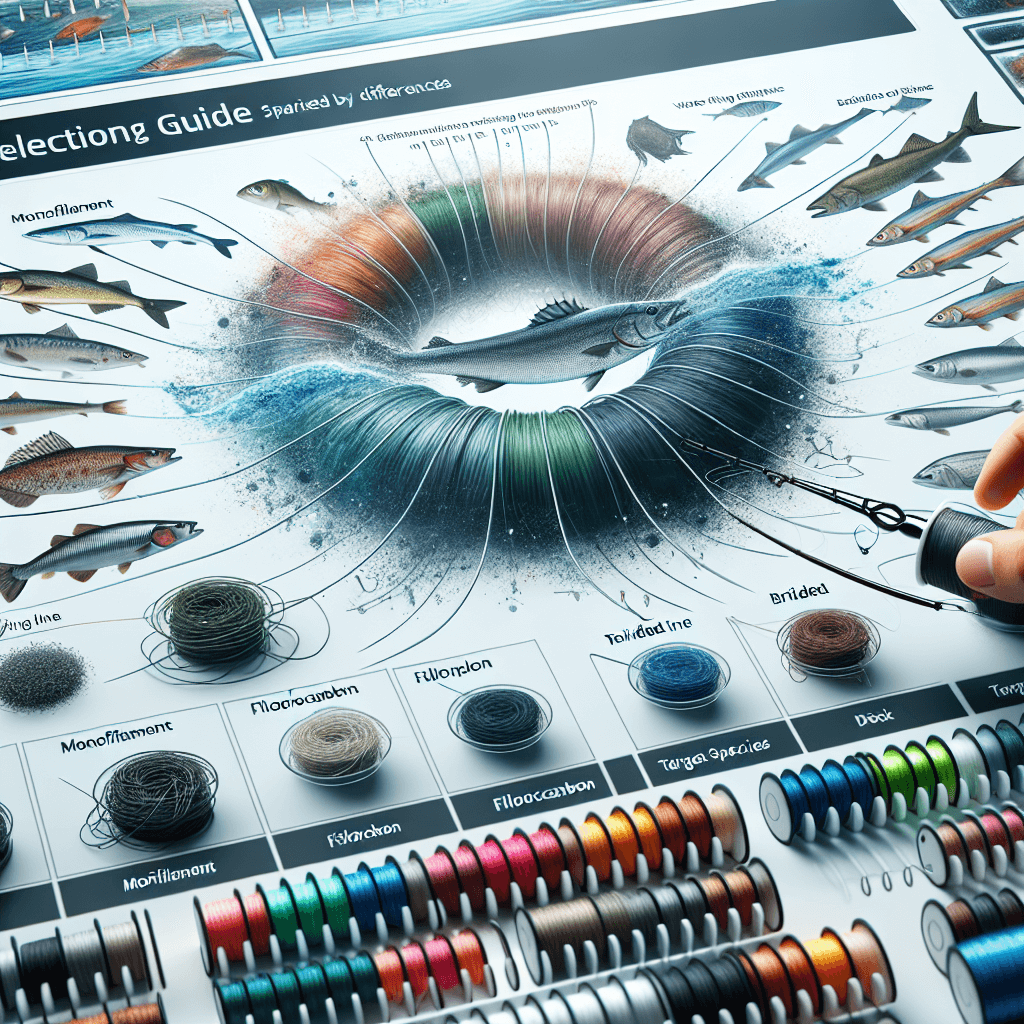In the world of fishing, selecting the right type of fishing line can make all the difference between reeling in a big catch or coming up empty-handed. With so many options available, it can be overwhelming to determine which fishing line is best suited for different fishing conditions and species. From monofilament to fluorocarbon and braided lines, each type has its own unique strengths and weaknesses. Whether you’re casting in clear waters or targeting a specific species, understanding the characteristics of different fishing lines is key to optimizing your fishing success. Let’s explore the best fishing line options for various fishing conditions and species, helping you make informed decisions that will maximize your chances of hooking a prize-worthy fish.
Freshwater Fishing
When it comes to freshwater fishing, there are a variety of species that you can target. Each species requires a slightly different approach, and choosing the right fishing line is an important part of that. Here, we will explore which fishing lines are best suited for specific freshwater species such as bass, trout, panfish, catfish, and pike.
Bass Fishing
Bass fishing is a popular choice amongst freshwater anglers, and there are several types of fishing lines that work well for this species. One popular option is monofilament line. Monofilament line offers good strength and versatility, making it a reliable choice for bass fishing. Another option to consider is fluorocarbon line, which is known for its invisibility underwater and excellent abrasion resistance. For bass fishing in heavy cover, braided line can be a great choice due to its excellent strength and durability.
Trout Fishing
Trout are known for their cunning nature and a successful angler needs to carefully choose the right fishing line for this species. Fluorocarbon line is often the go-to choice for trout fishing due to its nearly invisible nature in the water. Its low visibility helps to prevent spooking the trout. Additionally, fluorocarbon line sinks faster, allowing for more precise presentations in deeper waters where trout tend to hide.
Panfish Fishing
Panfish, such as bluegill and crappie, are popular targets for freshwater anglers looking for a fun day on the water. When it comes to fishing line for panfish, braided line is often a top choice. Braided line provides excellent sensitivity, allowing you to feel even the slightest nibble. Furthermore, it has a high strength-to-diameter ratio, making it perfect for reeling in panfish without the worry of breaking your line.
Catfish Fishing
Catfish are known for their strength and ability to put up a fight when caught. To ensure you have the best chance of landing a catfish, wire line is highly recommended. Wire lines are incredibly strong and durable, making them ideal for handling these powerful fish. Additionally, wire lines are resistant to abrasion, which is crucial when dealing with catfish’s rough mouths and the structures they inhabit.
Pike Fishing
Pike are predatory fish that require tough fishing lines to handle their sharp teeth and aggressive behavior. For pike fishing, lead core line is often the line of choice. Lead core lines have a lead core surrounded by a durable sheath, providing the strength and abrasion resistance needed when battling with these toothy monsters. The sinkability of lead core lines also allows for better control over the depth of the bait, maximizing your chances of enticing a strike.
Saltwater Fishing
Saltwater fishing offers a whole new set of challenges and opportunities for anglers. The species found in saltwater can range from snapper to marlin, each requiring a unique approach and fishing line choice.
Offshore Fishing
When heading offshore, you can find a variety of species such as tuna, mahi-mahi, and marlin. For offshore fishing, braided line is often a preferred choice due to its high strength and excellent sensitivity. The strength of braided line allows anglers to battle with larger species, while its sensitivity ensures that even the slightest nibble is detected. In addition to its strength, braided line has a small diameter, allowing for more line capacity on the reel.
Inshore Fishing
Inshore fishing takes place in shallower waters closer to the coast, where species like redfish, snook, and tarpon can be found. For inshore fishing, fluorocarbon line is often the line of choice. Fluorocarbon line’s nearly invisible properties make it ideal for fooling wary fish in clear water conditions. Its resistance to abrasion is also important when fishing around structures such as oyster beds or submerged rocks.
Surf Fishing
Surf fishing provides anglers with the chance to target a variety of species such as striped bass, snook, and pompano. When it comes to surf fishing, braided line is an excellent choice. The strength and durability of braided line are crucial when casting heavy lures or bait into the surf. Additionally, its sensitivity allows anglers to detect subtle bites even when dealing with the powerful waves.
Deep Sea Fishing
Deep sea fishing is an exciting and challenging pursuit, targeting species such as tuna, swordfish, and marlin. Wire line is often the line of choice when it comes to deep sea fishing. Wire lines are highly durable and resistant to the teeth and abrasive scales of these large saltwater species. The added strength and durability of wire lines ensure that you have what it takes to land these trophy fish.
Kayak Fishing
Kayak fishing is a unique and thrilling way to pursue saltwater species such as redfish, snook, and trout. When kayak fishing, it’s essential to have a fishing line that is strong, durable, and has low visibility. Fluorocarbon line is a great option for kayak anglers as it provides the necessary stealth while still offering the strength and abrasion resistance needed to handle saltwater fish.

Types of Fishing Lines
Now that we have explored which fishing lines are best suited for various freshwater and saltwater species, let’s dive deeper into the different types of fishing lines available.
Monofilament Line
Monofilament line is a versatile and popular choice amongst anglers. It is made from a single strand of nylon, offering excellent knot strength and ease of use. Monofilament line is available in various strengths and is suitable for a wide range of fishing techniques. However, it may not be as invisible underwater as fluorocarbon line.
Fluorocarbon Line
Fluorocarbon line is known for its nearly invisible nature underwater. It is made from a dense and clear material that refracts light in a way that makes it less visible to fish. Fluorocarbon line also offers excellent abrasion resistance, making it suitable for fishing in areas with rocky bottoms or structures.
Braided Line
Braided line is a strong and durable fishing line made by weaving together multiple strands of synthetic fibers, such as Spectra or Dyneema. Braided lines have a high strength-to-diameter ratio, providing excellent sensitivity and allowing for long casts. They are also suitable for various fishing techniques, including freshwater and saltwater fishing.
Wire Line
Wire lines are made from stainless steel strands woven together to create a strong and durable fishing line. Wire lines are ideal for targeting species with sharp teeth, such as pike and barracuda. They are resistant to abrasion and can handle the high speeds and aggressive strikes of these predatory fish.
Lead Core Line
Lead core line is a specialized fishing line that has a lead core surrounded by a durable sheath. The lead core gives the line weight, allowing it to sink to a desired depth. Lead core lines are commonly used in trolling or deep-water fishing for species like pike and walleye. They provide better control over the depth at which the bait or lure is presented.
Factors to Consider
When choosing the right fishing line, there are several factors that you need to consider, including the species of fish you are targeting, the fishing method you will be using, the water clarity, the strength of the line, and its visibility.
Fish Species
Different species of fish require different types of fishing lines due to their unique behaviors and habitats. For example, species with sharp teeth, like pike or barracuda, may require wire lines to prevent them from cutting through the line. Understanding the species you are targeting can help you choose the most suitable fishing line.
Fishing Method
The fishing method you plan to use also affects the choice of fishing line. Different techniques, such as trolling, casting, or bottom fishing, require different types of lines. For example, trolling often requires lines with higher strength and durability to withstand the pressure of the moving boat and the powerful strikes from larger fish.
Water Clarity
Water clarity plays a significant role in determining the visibility of the fishing line. In clear water conditions, using a low-visibility line, such as fluorocarbon, can increase your chances of fooling fish that are easily spooked. In murkier waters, where visibility is limited, you may opt for more visible lines to ensure that the fish can find your bait or lure.
Line Strength
The strength of the fishing line is crucial in ensuring that it can handle the weight and fight of the fish you are targeting. Matching the line strength to the size and strength of the fish species is essential for successfully landing your catch. Using a line that is too weak may result in break-offs, while using a line that is too strong may diminish the sensitivity required to detect bites.
Line Visibility
The visibility of the fishing line is an important factor, as fish can be deterred by the sight of a line in the water. In clear water conditions or when targeting finicky fish, using a low-visibility line, such as fluorocarbon, can increase your chances of getting more bites. However, in situations where visibility is not a concern, using a more visible line can help you track and control your bait or lure more effectively.

Best Fishing Lines for Freshwater Species
Now let’s explore the best fishing lines for some of the most popular freshwater species.
Bass
For bass fishing, monofilament line is a popular choice due to its versatility and strength. It offers good knot strength and is suitable for various fishing techniques, including casting, flipping, and topwater fishing. Fluorocarbon line is also a great option for bass fishing, especially in clear water conditions, as its nearly invisible nature helps fool wary bass.
Trout
When it comes to trout fishing, fluorocarbon line is often the line of choice. Its near-invisibility in the water helps prevent the trout from getting spooked, increasing your chances of getting more bites. Additionally, fluorocarbon line sinks faster, allowing for more precise presentations in deeper waters where trout tend to hide.
Panfish
Braided line is a top choice for panfish fishing. The excellent sensitivity of braided line allows anglers to feel even the slightest bites from these small but feisty fish. Braided line also has a high strength-to-diameter ratio, allowing for longer casts and better control over your line.
Catfish
When it comes to catfish fishing, wire line is highly recommended. Catfish are known for their strength and their ability to put up a fight. Wire lines offer excellent strength and durability, making them ideal for handling these powerful fish. Additionally, wire lines are resistant to abrasion, which is crucial when dealing with catfish’s rough mouths and the structures they inhabit.
Pike
For pike fishing, lead core line is often the line of choice. Pike are aggressive and have sharp teeth, making it important to have a line that can withstand their bites. Lead core lines provide the strength and durability needed to handle pike, while also allowing for better control over the depth of the bait, maximizing your chances of enticing a strike.
Best Fishing Lines for Saltwater Species
Now let’s turn our attention to the best fishing lines for various saltwater species.
Snapper
For snapper fishing, monofilament line is a popular choice. Monofilament line provides good knot strength and is suitable for bottom fishing techniques commonly used when targeting snapper. Its versatility and reliability make it a great option for anglers pursuing these tasty fish.
Tarpon
Fluorocarbon line is often the line of choice for tarpon fishing. The nearly invisible nature of fluorocarbon line helps to prevent spooking the wary tarpon, increasing your chances of getting a strike. Additionally, fluorocarbon line’s resistance to abrasion is important when targeting tarpon in rocky or structure-filled areas.
Redfish
Braided line is a top choice for redfish fishing. The strength and durability of braided line make it perfect for battling with strong redfish. Additionally, its excellent sensitivity allows anglers to detect the subtle bites of redfish, making sure that no strikes go unnoticed.
Tuna
When targeting tuna, wire line is often the line of choice. Tuna are known for their strength and their ability to make long runs, making it essential to have a strong and durable line. Wire lines can handle the high speeds and powerful strikes of tuna, ensuring that you can bring these exciting fish to the boat.
Marlin
For targeting marlin, lead core line is often the line of choice. Marlin are incredibly powerful fish, and a line with high strength and durability is a necessity. Lead core lines offer the needed strength, while the ability to control the depth of the bait allows for effective presentation of lures when targeting these magnificent fish.

Choosing the Right Line for Freshwater Fishing
Now that we have discussed the best fishing lines for different freshwater species, let’s dive into choosing the right line for specific freshwater fishing scenarios.
Monofilament Line for Bass
When targeting bass, monofilament line is often a great choice. Its versatility allows for various fishing techniques commonly used when pursuing bass, such as flipping, casting, or topwater fishing. Monofilament line also offers good knot strength and excellent shock absorption, making it reliable when battling with aggressive bass.
Fluorocarbon Line for Trout
Fluorocarbon line is highly recommended for trout fishing, especially in clear water conditions. Its nearly invisible nature allows for a stealthy presentation, ensuring that trout are not spooked by the fishing line. Additionally, fluorocarbon line sinks faster, allowing for precise presentations in deeper waters where trout often hide.
Braided Line for Panfish
Braided line is an excellent choice for panfish fishing due to its sensitivity and strength. Panfish, such as bluegill and crappie, can be subtle in their bites. The excellent sensitivity of braided line allows anglers to feel even the slightest nibble, greatly increasing their chances of hooking these small but tasty fish.
Wire Line for Catfish
When targeting catfish, wire line is highly recommended. Wire lines provide the necessary strength and durability to handle these powerful fish. The resistant nature of wire lines to abrasion ensures that you can bring catfish to the surface without worrying about the line snapping or getting damaged.
Lead Core Line for Pike
Pike are predatory fish known for their sharp teeth and aggressive behavior. To handle these toothy monsters, lead core line is often the best choice. The lead core provides the necessary strength and durability to handle pike, while the ability to control the depth of the bait ensures that you can effectively present your lure in their strike zone.
Choosing the Right Line for Saltwater Fishing
Now let’s dive into choosing the right line for specific saltwater fishing scenarios.
Monofilament Line for Snapper
For snapper fishing, monofilament line is often a reliable choice. Monofilament lines provide good knot strength and versatility, making them suitable for various bottom fishing techniques commonly used when targeting snapper. Its strength and durability ensure that you can handle the powerful strikes and the fight of these popular saltwater species.
Fluorocarbon Line for Tarpon
When pursuing tarpon, fluorocarbon line is highly recommended. The nearly invisible nature of fluorocarbon line prevents spooking these wary fish, as they are known to be easily frightened. Additionally, fluorocarbon line’s resistance to abrasion is crucial when targeting tarpon, as they tend to be found near structures or oyster beds.
Braided Line for Redfish
Redfish are known for their strength and aggressive behavior, making braided line a popular choice for targeting them. Braided line provides excellent sensitivity, allowing anglers to detect even the slightest bites. Its high strength is crucial when battling with these powerful fish, ensuring that you can bring them to the boat successfully.
Wire Line for Tuna
When targeting tuna, wire line is often the line of choice. Tuna are powerful fish that can make long runs and put up a strong fight. Wire lines are highly durable and resistant to the teeth and abrasive scales of tuna, making them ideal for handling these trophy fish.
Lead Core Line for Marlin
Marlin are one of the most sought-after saltwater gamefish, and lead core line is often the line of choice when targeting them. The strength and durability of lead core lines make them suitable for handling the powerful strikes and the long fights that come with marlin fishing. The ability to control the depth of the bait is also important to ensure an effective presentation.

Additional Tips and Considerations
In addition to choosing the right fishing line for specific species and fishing conditions, here are some additional tips and considerations to ensure a successful fishing experience.
Matching Line to Fishing Method and Target
It’s important to match your fishing line to the fishing method you plan to use and the target species you are pursuing. Different fishing methods require different lines, and using the right line can greatly improve your chances of success. Additionally, choosing a line that matches the size and strength of your target species ensures that you have the necessary strength to land your catch.
Adjusting Line Strength Based on Fish Size
When pursuing different-sized fish, it’s important to adjust the strength of your fishing line accordingly. Using a line that is too weak for the size of the fish may result in break-offs, while using a line that is too strong may diminish the sensitivity required to detect bites. Understanding the size and strength of your target species will help you choose the appropriate line strength.
Considering Water Clarity and Visibility
The clarity of the water and the visibility of your fishing line can greatly affect your chances of success. In clear water conditions, using a low-visibility line, such as fluorocarbon, can increase your chances of fooling fish that are easily spooked. However, in murkier waters or when visibility is not a concern, using a more visible line can help you track and control your bait or lure more effectively.
Checking Line for Wear and Damage Regularly
Before each fishing trip, it’s important to inspect your fishing line for any signs of wear or damage. Look for any nicks, abrasions, or weak spots along the line. If you notice any damage, it’s advisable to replace the line to prevent any potential break-offs during a fishing trip. Taking the time to regularly check your line will ensure that it remains in optimal condition.
Using Backing Line for Extra Capacity
When fishing for large or powerful fish, it may be necessary to use backing line to increase your line capacity. Backing line is a thinner line that is spooled onto the reel first, followed by the main fishing line. By using backing line, you can increase the amount of line available on your reel, allowing for longer runs and reducing the chances of running out of line during a fight.
Conclusion
Choosing the right fishing line is an important factor in ensuring a successful and enjoyable fishing experience. Whether you are targeting freshwater species like bass, trout, panfish, catfish, or pike, or saltwater species like snapper, tarpon, redfish, tuna, or marlin, understanding the characteristics and qualities of different fishing lines will greatly improve your chances of landing your desired catch.
Consider the behavior and habitat of your target species, the fishing method you plan to use, the water clarity, the line strength, and its visibility when selecting the most suitable fishing line. By making informed decisions about the type of fishing line to use, you will increase your chances of success and make your fishing trips more enjoyable. So, grab your preferred fishing line, head out to your favorite fishing spot, and enjoy the thrill of reeling in your catch of a lifetime. Happy fishing!


